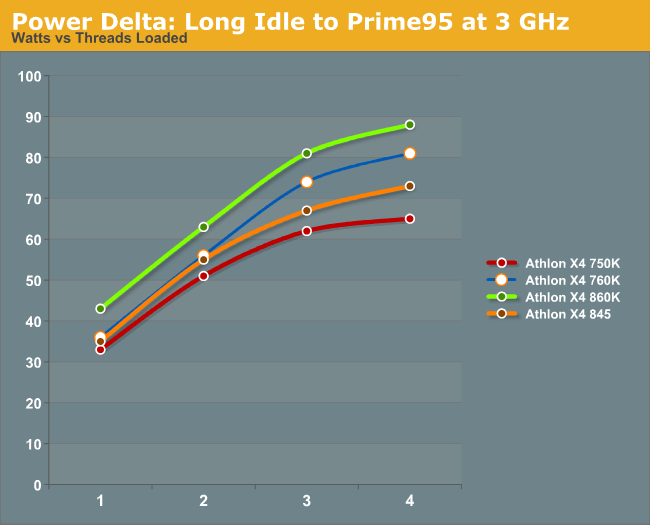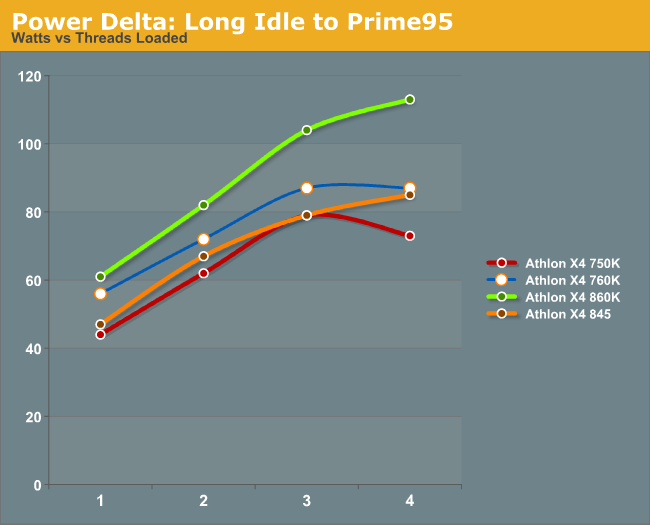AMD Carrizo Part 2: A Generational Deep Dive into the Athlon X4 845 at $70
by Ian Cutress on July 14, 2016 9:00 AM ESTPower Consumption
Power consumption was tested on the system while in a single MSI GTX 770 Lightning configuration with a wall meter connected to the power supply. This power supply is 80PLUS rated, and as I am in the UK on a 230-240 V supply, leads to ~75% efficiency > 50W, and 90%+ efficiency at 250W, suitable for both idle and multi-GPU loading. This method of power reading allows us to compare the power management of the UEFI and the board to supply components with power under load, and includes typical PSU losses due to efficiency.
Our Power Consumption tests have changed slightly since our last review as we are testing out new ways to represent the power used by the CPU and the system. The current three standard tests start with a system at long idle, meaning that the OS turns off the monitor and enters a lower power state without going into S3. We then move into a standard idle state on the desktop, with no software running but the desktop on display. The system is then moved into high performance mode, and we run a one-minute OCCT test to identify peak power consumption.
Due to extended requests, our power consumption numbers also use Prime95 to load the system. We use Prime95's peak power consumption mode, testing 1/2/3/4 thread consumption at the wall with our power meter. P95 hits the peak power relatively quickly, making this a straightforward test to include. For CPUs above 4 threads, we typically manage powers of two, half the CPU, and the full CPU to get an accurate picture.
For this review, we performed the power analysis for all four main CPUs at the 3 GHz frequency (using automatic voltage on the motherboard), as well as at stock frequencies. The values shown are delta values to the long idle power consumption, due to power delivery variations.
Generational Power Consumption at 3 GHz
All four processors have a 2-3W difference moving from a long idle to an idle state, however it is clear that our Carrizo CPU, which we stated is well outside its normal efficiency window at the beginning of this review, has a very good response during OCCT loading.

These results are within 3-4W of the full loading provided by Prime95 as well. If we analyze the per core jumps from moving up the threads using Prime95, there are some interesting numbers to pick out.

All the processors increase their power consumption by ~20W when both modules are loaded, when moving from 1 core loading to 2 core loading. When moving to 3/4 core loading, it is obvious that as both modules are already running at high frequency, a smaller amount of power is needed for each to enable the second thread.
Power Consumption at Stock
For those keeping track, we were not able to source identical TDP rated processors for this test. While the Carrizo based Athlon is 65W, the other processors are at the 95W/100W level. This makes total power consumption numbers relatively processional, and it becomes interesting looking into how close each processor gets to its TDP.
In our testing, the X4 845 seems to go beyond its 65W TDP, pushing almost another 9W through our power meter. This is only 8W away from the X4 750K, which should be 35W ahead. However, it would seem that for the X4 845, P95 draws an extra 15W compared to OCCT, but for the X4 750K, it draws 10W less, showing how difficult it can be to retain consistency. It is worth noting that TDP ratings are difficult to interpret in this way - the processors coming out of the fabs will have a statistical variation to their operating voltage, and this differs between samples. A good sample of a high TDP compared to a bad sample of a low TDP might seem to generate an interesting story, however without having access to several dozen units it can be strained to draw many conclusions.

Looking at the Prime95 core-loading numbers, we see a similar pattern to what happened at 3 GHz, despite the X4 760K getting the same power reading for 3/4 core loading and the X4 750K actually decreasing in power with four loaded threads.










131 Comments
View All Comments
lefty2 - Thursday, July 14, 2016 - link
I'm predicting Bristol Ridge will be just as bad a failure as Carrizo. I.e. the few design wins will only have single DIMM memory and be universally unavailable, buried somewhere in a dark corner of the OEM's website. It's a pity, because both SoCs are very good in their own right.nandnandnand - Thursday, July 14, 2016 - link
If it's not Zen, it can be thrown straight in the garbage.Samus - Friday, July 15, 2016 - link
I still rock a few Kaveri desktops and they are incredibly powerful for the price. The 860K is half the cost of a comparable Intel chip, which supporting faster memory and a lower cost platform.Carizo on the desktop is an anomaly. I'd like to see what it could do with 4MB cache (would require an entirely new die)
Lolimaster - Saturday, July 16, 2016 - link
They were nice in 2014.We should have a nice 20nm 768SP APU in 2015 with a full L2 cache Excavator and fully mature 896SP 20nm early this year.
Remember the A8 3870K? That APU was a damn monster only hold back from being godly cause of their sub 3Ghz cpu speed, what we had after?
400SP VLIW5 2011 --> 384 VLIW4 2012 --> 384VLIW4 2013 --> 512SP GCN 2015 --> 512SP GCN 2016
Intel improved way faster (non "e" + edram igp's are near A8 level from being utter trash when the A8 3850 was release).
The_Countess - Tuesday, July 19, 2016 - link
yes being able to thrown in a extra billion transistors compared to AMD (1.7 vs 0.75 billion transistors for a quad core with GPU) because of 14nm really does help intel along a lot.but as nobody has been able to make a 20nm class process for anything but flash and ram besides intel, AMD's hands were tied. there is nothing AMD could have done to change that.
BlueBlazer - Friday, July 15, 2016 - link
Formula for failure: FM2 socket (with limited CPU upgradeability), only PCI Express x8 lanes available (which can bottleneck GPUs), and only "4 cores" (which performs more like 2C/4T Core i3 processor).neblogai - Friday, July 15, 2016 - link
Bristol Ridge is not FM2; PCI-E x8 can not bottleneck midrange GPUs; ultra low power mobile APU also sold as desktop chip is not a failure, just additional revenueBlueBlazer - Friday, July 15, 2016 - link
The results in the article shows otherwise, where AMD's Bristol Ridge was slower in most gaming tests, despite having better performance in some applications. Both FM2 and FM2+ are still the same (legacy) socket. AMD will be probably selling these chips at a loss. Note that these are the same (large) dies as Carrizo chips, and at 250mm^2 coupled with low prices typically meant razor thin margins or none at all.silverblue - Friday, July 15, 2016 - link
That L2 cache is probably making more difference than you realise.evolucion8 - Saturday, July 16, 2016 - link
The PCI-E is busted, even at PCI E 2.0 @ 4X, it barely makes a difference on the Fury X and the GTX 980 Ti.